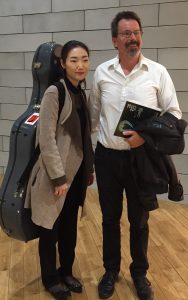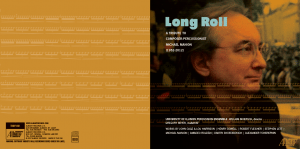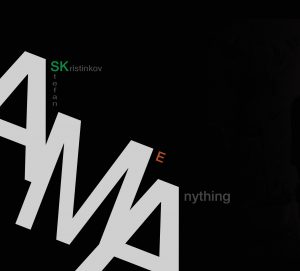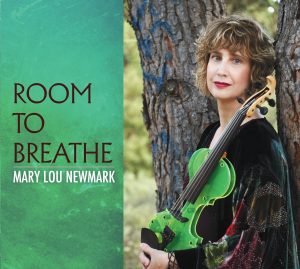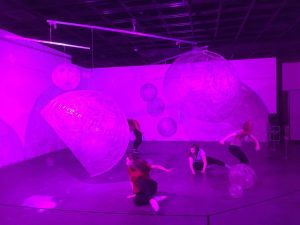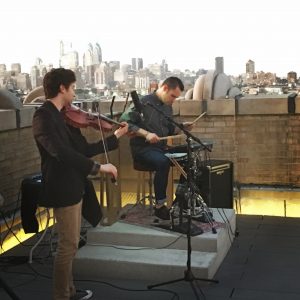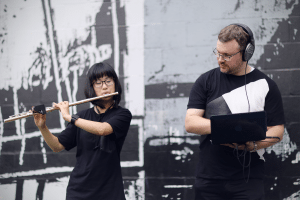Fall 2017
Based on recent work in creating resonating sound objects, Beth Bradfish recently won a six-month Field/Work residency with the Chicago Artists Coalition. A sample of Exhale, a sonic bed, has been uploaded to the SEAMUS members new works: https://seamusonline.org/work/exhale-a-sound-object/
Mediums of Electronic Music (2017), by Thomas D. Brosh, is a summary of his 50 years using synthesizer technology. Beginning with an introduction to the Buchla and EMS systems, this article is a discussion of his compositions for tape alone, tape with acoustic instruments and live synthesizer with acoustic instruments. Based upon previous Mediums of Electronic Music lecture-demonstrations, it was written for his archive at the American Music Research Center, University of Colorado-Boulder.
News from Kyong Mee Choi:
Orpheus with his lute for mezzo-soprano and piano will be premiered by Re’ut Ben-Ze’ev and Mila Henry at the Phoenix Concert at the Saint Matthew & Saint Timothy on Tuesday, December 12, 2017 at 7:30 p.m. The concert will feature works by Kathryn Alexander, Gabriel Bolaños Chamorro, Kyong Mee Choi, Daron Hagen, Libby Larsen, Paula af Malmborg Ward and Steven Gerber. The program centers on three poems – one each on earth, water, and air. More info can be found here.
MOMENT for haegeum, flute, clarinet, trombone, piano, and percussion will be premiered by Soo-yeon Lyuh (haegeum) and players from the mise-en ensemble at the cell (338 w 23rd st) in New York on Wednesday, December 6, 2017 at 8 p.m. The concert will feature works by Kari Besharse, Kyong Mee Choi, Timothy Johnson, and Gideon Kim.
Rippled Pond for violin, cello, and piano was performed by the Lincoln Trio (Desirée Ruhstrat, violin; David Cunliffe, cello; and Marta Aznavoorian, piano) at 6 Degrees Composers concert in Ganz Hall, Roosevelt University on Sunday, November 19, 2017 at 2:30 p.m. The concert will feature works by Regina Harris Baiocchi, Kyong Mee Choi, Janice Misurell-Mitchell, and Patricia Morehead. The same piece was also performed by the Fifth House Ensemble Piano Trio (Charlene Kluegel, violin; Herine Coetzee Koschak, cello; Katherine Petersen, piano) in Ganz Hall, Roosevelt University on Tuesday, November 14, 2017.
rare yet soft was presented at the Third Practice Fesitval at the Third Practice Electro-Acoustic Music Festival at University of Richmond, Richmond, VA on Friday, November 3, 2017. The piece explores the subtlety of quoted thematic material from Mahler’s Symphony No. 5 Adagietto. The piece has three sections when each quote is introduced in a different context. At the end, the piece shows how subtle influence of this quotation can affect the overall shape of the piece. This piece is dedicated the composer’s beloved father, Soon Bong Choi.
what prevails for clarinet, violin, and piano was performed by Christopher Nichols, clarinet, Stephanie Westney, violin, Ivan Hurd, piano at the sixtieth College Music Society National Conference at the Travis Park United Methodist Church (230 E Travis St, San Antonio) in San Antonio, TX on Friday, October 27, 2017 at 7:30 p.m. This piece is dedicated to those innocent people who were killed by acts of crime and violence.
Rippled Pond for violin, cello, and piano, was performed at the Livewire Festival at the University of Maryland, Baltimore (UMBC) on Thursday, October 26 at 7:30 p.m. The UMBC Department of Music presentsLivewire 8: Asian Music in America, a festival of contemporary music that will explore the creativity of composers with cultural connections to China, Japan, Korea, Taiwan, and Vietnam. Music of ten composers, including Shih-Hui Chen, Kyong Mee Choi, Mandy Fang, Hitomi Kaneko, Liza Lim, Toshiro Mayuzumi, Tokuhide Niimi, and P. Q. Phan, was performed by UMBC faculty and students, including the Ruckus contemporary faculty music ensemble.
Ceaseless Cease was performed by Derek Emch at the Bowling Green State University New Music Festival on Friday, October 21 at 2:30 p.m. The concert features works by Kyong Mee Choi, Asha Srinivasan, Mike McFerron, Scott Miller, Jay C. Batzner, and Konstantinos Karathanasis. For the detailed info of the entire festival, please click here.
Brad Decker recently performed recitals of my new works for double bass and computer. “Karma is a Cruel Mistress,” “Sudden Death,” “Ricercar” (featuring video by Zlatko Cosic) and “The Devil You Know (vs. The Devil You Don’t)” were performed at the University of Illinois at Urbana-Champaign on October 26, 2017, and at Lewis University in Romeoville, Illinois on November 17, 2017. Decker also performed “The Devil You Know…” at the 2017 SCI National Conference at Western Michigan University, Kalamazoo, MI, April 1, 2017.
Brad Decker
Christopher Dobrian gave a lecture about his research on “Gesture, Acceleration, and Expressivity” at the annual conference of the Korean Electro-Acoustic Music Society (KEAMS) in October, and his composition Point of No Arrival for cello and computer was performed by Hea-Mee Kim in the Seoul International Computer Music Festival (SICMF) at the Asia Culture Center in Gwangju.
Chris Dobrian and Hea-Mee Kim
In early November Christopher Dobrian did a tour of concerts, lectures, and master classes at the University of South Florida, Furman University, Columbus State University, Georgia Southern University, and the Georgia Institute of Technology with pianist Daniel Koppelman. The concerts featured several of his works for computerized piano, including the premiere of his latest piece, Touch and Go for iPad-controlled piano.
Robert Fleisher’s Maniondala (Gregory Beyer, malletKAT) is included on the Albany Records CD, “Long Roll: A Tribute to Composer-Percussionist Michael Manion (1952-2012),” released December 1. The first commercially released recording of the University of Illinois Percussion Ensemble (William Moersch, director) in many years, this collection includes works by John Cage & Lou Harrison, Henry Cowell, Amadeo Roldán, Dmitri Shostakovich, and Alexander Tcherepnin, and features first recordings of Fleisher’s Maniondala, Steven Lett’s trio Junta, and Michael Manion’s quartet Long Roll II, from which the album’s title derives. Maniondala (2009) is dedicated to Michael Manion, who commissioned this solo work for malletKAT, but was never able to perform again following a stroke in 2008. Manion was a percussionist and a prolific composer of acoustic and electroacoustic music, whose sketches, compositions, and recordings were entrusted by his family to the Sousa Archives/Center for American Music at the University of Illinois after his death in 2012. During his two decades studying, composing, and performing in Europe, Manion was also employed by the composer Karlheinz Stockhausen.
Jeffrey Hass, Director of the Indiana University Center for Electronic and Computer Music, had a premiere of his ballet-based video Capsule featuring 3D motion graphics and an original computer music score this past Sunday, December 3 in Bloomington, Indiana. Capsule was commissioned by the Jacobs School of Music in honor of its 100th anniversary. The 9-minute work can be viewed online here: https://vimeo.com/230491334
Lauren Sarah Hayes was commissioned by the Huddersfield Contemporary Music Festival 2017 to create a new work for their 40th edition. The 25 minute live electronics improvisation was broadcast as part of the hcmf// International Showcase on BBC Radio 3’s Hear and Now alongside works by Pauline Oliveros and
Enno Poppe. The world premier broadcast is available here: http://www.bbc.co.uk/programmes/b09gxj10
“A.M.A. (Ask Me Anything)” is the first full-length album featuring Stefan Kristinkov as a composer and a clarinet player. This project is the culmination of many years of endeavor from Stefan, and was inspired by influences encompassing the full scope of his musical development. From Stravinsky to NIN, the list of Stefan’s influences reads like a history of heavy-duty basslines throughout the ages.
A question listeners could pose to Stefan in response to his request for them to ask him anything, could be how he has brought the clarinet from the side of the orchestra to the centre of an EDM album. Stefan nicknamed this album ‘A clarinet like you’ve never heard it before’ to illustrate the delightful fusion between classical and dance music lying at the heart of “A.M.A. (Ask Me Anything)”. You can experience this intriguing project for yourself right now, as “A.M.A. (Ask Me Anything)” is currently available for purchase, streaming and download on all major platforms.
Download or stream “A.M.A. (Ask Me Anything)” now on
Apple Music: https://itunes.apple.com/us/album/a-m-a-ask-anything/id1286859779
Spotify: https://open.spotify.com/album/7JNMjGIVzCsbm72D0dIDfH
Joungmin Lee made a presentation at the 2017 AGU(American Geophysical Union) Fall Meeting, taking place on 11-15 December, in New Orleans, Louisiana. The following abstract describes his work and the presentation:
“Threatened by: A music inspired by scientific data about glaciers and climate change.”
“Glaciers often have been considered as a symbol of climate change, also its mass change is a major contributor to sea level rise. Dynamic discharge is one of the mechanisms that marine-terminating outlet glaciers loses its mass, whose trend consists of seasonal, annual and secular patterns. These patterns, along with the other climate parameters, can be inspirational to music composition, thereby it can be expressed and transferred by musical media.
“Here we present ‘Threatened by,’ a piece of electronic music which represent an attempt to frame the sound of the glacier in freer ways vis-à-vis acoustic music. To give expression to the sound, musical production tools such as Pro tool, Sound Forge Pro, Logic Pro X, Max MSP, etc. are utilized to modify and combine a variety of sounds generated by a melting glacier. After adding impact by the way of EQ, reverberation, distortion, delay, reversal, etc., I created a two-channel stereo piece in approximately 7 minutes. I will also compose a video clip to make a poster presentation.
“We expect this work will raise awareness of glaciers’ behavior to general public, also presenting one of the examples that scientists and artists work collaboratively to come up with an artwork that has social implications.”
Last November 16th the work titled “The Web” by Fernando Laub was played at the Ecos Urbanos Festival in Mexico City.
It was an eight channel concert. Here you can listen a stereo excerpt of the piece:
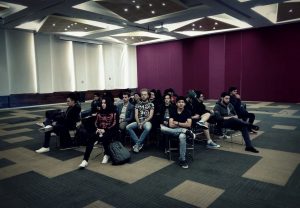
https://soundcloud.com/flaub/the-web-stereo-version-excerpt/s-qYcbx
Niels Mestre recorded a solo album:
https://nielsmestre.bandcamp.com
and did a tour in Japan:
Electric violinist, composer and poet, Mary Lou Newmark, released her third CD, “Room to Breathe” this October. The album is a safari into the urban wilderness of Los Angeles. The music moves across genres to encounter coyotes, wild birds, a wolf woman, and poetic verse.
“Room to Breathe” is being played on radio stations across the US. It is available on iTunes, CD Baby and Spotify.
September through December, Charles Nichols’ composition Underlying Space, for recorded processed electric violin, accompanied the 30×30 art installation by artist Paola Zellner Bassett, at the Kibel Gallery of the School of Architecture, Planning and Preservation at the University of Maryland in College Park, MD and at the American Institute of Architects National Headquarters in Washington, DC. In September, the PEN Trio performed his piece Wunderkammer, for oboe, clarinet, bassoon, and computer music, on recitals at Ball State University, Western Michigan University, Butler University, and Indiana University. In October, his composition Beyond the Dark, for computer music, accompanied the Dense Space art installation, by artist Paola Zellner Bassett, at the ACCelerate Smithsonian Creativity and Innovation Festival at the National Museum of American History in Washington, DC, and his piece What Bends, for computer music and video, with video artist Zach Duer, was presented at the International Composers and Interactive Artists One Voice, Two Lands Concert, at the The DiMenna Center for Classical Music in New York, NY. In November, the Beo String Quartet premiered his composition Or Be Forever Fallen, for amplified string quartet, computer, and video, with video artist Zach Duer, at Virginia Tech, and in December, the Washington & Jefferson Jazz Ensemble premiered his piece Upstream, for jazz band, at Washington & Jefferson College.
Paola Zellner Bassett’s art installation Dense Space II: Il Mobile, at the National Museum of American History in Washington, DC, accompanied by Charles Nichols’ composition Beyond the Dark, during the ACCelerate Smithsonian Creativity and Innovation Festival, with dancers from the North Carolina State University Dance Company
Sam Pluta, Assistant Professor at the University of Chicago, just released Broken Symmetries, an album of electro-acoustic works on Carrier Records. The album features performances by Mivos Quartet, Wet Ink Ensemble, and Anne La Berge. Pluta performs electronics on three of the four works. The album can be found on the Carrier Records website, www.carrierrecords.com. It is also available for streaming on various platforms. In other news, Sam looks forward to his role as Guest Composer in this upcoming summer’s SPLICE Institute!
Hanna Lisa Stefansson received her Doctor of Musical Arts degree from the University of Georgia in August 2017. Her dissertation, titled “Ritual Habit: An electroacoustic music composition and dance collaboration,” was performed April 8th in the Dancz Center for New Music at UGA. The performance includes archetypes of ritual outlined by the late scholar Catherine Bell, including formalism, invariance, and performance.
The following text is an excerpt from the program notes:
“The concept of ritual has always fascinated me. Why is it that all known human civilizations have incorporated a form of ritual into their societies? From the common greeting of handshaking to ceremonies for the purpose of marking time, rituals serve as a way for humans to interact with each other and with the environment. Each of the four dancers featured in Ritual Habit represents a natural element – Earth, Water, Air, and Fire. After the musicians and dancers arrive at their starting positions, the dancers begin to “cast the space,” marking the space that they will inhabit during the performance. Four movements follow this section in which each element is featured as a solo with support from the other dancers. The percussion and flute evoke these qualities as well, often reacting to and triggering the dancers’ movements. The movements highlight the qualities of the elements in the following ways: Earth – roots, seed, soil, the core as well as the atmosphere above Water – droplets, washes, bubbles, malleability Air – breath, gusts, flocking Fire – glowing ember, crackles, warmth, burns The elements come together for the ritual, which incorporates the following archetypes outlined by the late scholar Catherine Bell: formalism, invariance, and performance. As Catherine Bell explains, “When analyzed, formality appears to be, at least in part, the use of a more limited and rigidly organized set of expressions and gestures.” Formalism also creates the boundary between the ritual participants and the observers. Invariance implies careful choreography and bodily discipline, striving for timeless repetition. This characteristic is often displayed in groups and in unison. The performance of a ritual creates a theatrical frame around the events, participants, and objects involved in the ritual. Also featured in the performance is the element of mystery. What is the significance of the ritual, the objects, the movements, and the sounds? Some rituals do not reveal the entire meaning to the observers, leaving them to solve the puzzle.”
The performance video may be viewed via this link:
https://www.youtube.com/watch?v=XyT4-qA1Hhc
Mike Testa’s new album electroacoustic “Compositions” dropped in September. It is available on all major digital distribution outlets (apple iTunes, Spotify, etc).
Also, Dr. William Pfaff and Testa will be performing their duo group named “Cepheid” on March 3rd, 2018 at SUNY Plattsburgh NY. It is an electro-acoustic group that will feature some new instrumental inventions as well Dr. Pfaff’s performance on the Madrona Labs SoundPlane instrument.
For more information, contact: [email protected].
Adam Vidiksis is serving as Composer in Residence for the Chamber Orchestra of Philadelphia this season, the focus of which is improvisation. Vidiksis inaugurated his residency with performances at the season opening galas at the Philadelphia Clef Club of Jazz and The Bok Bar. Most recently, the Chamber Orchestra performed two of Vidiksis’s works at the Kimmel Center. Additionally, Vidiksis performed his original compositions, as well as other works, as the featured guest artist at Rutgers University, New Brunswick’s New Jersey Digital Arts Concert and Rutgers University, Camden’s Electric Café. Vidiksis performed the premiere of a new work for electronic drum kit entitled, Under the Verrazano-Narrows Bridge, at the International Composers and Interactive Artists FUSE Festival at the DiMenna Center in New York City, followed by the Philadelphia premiere at Temple University’s Cybersounds series. Vidiksis joined his fellow members of SPLICE Ensemble for a midwest tour, which included performing as the featured guest ensemble for Electronic Music Midwest, as guest ensemble at the University of Central Missouri and Wayne State University, and at the Detroit Symphony Orchestra’s Strange and Beautiful Music Festival. Both Vidiksis’s recent release of Local Equilibrium Dynamics on Music from SEAMUS, Vol. 26, and his work with Allendance company, Time, received critical acclaim this fall.
[photo by Stefano Daddi]
Framed by the Philadelphia skyline, Adam Vidiksis performs with Chamber Orchestra of Philadelphia’s principal violist, Matthew Cohen at the Bok Bar to inaugurate Vidiksis’s tenure as Composer in Residence for the 2017-2018 season, focusing on improvisation.
John Wiggins’ acousmatic composition STRING II, won Honorable Mention at the MA/IN Festival in Matera Italy and plays currently in the Case Cave Auditorium.
Here’s a link:
http://www.materaintermedia.it/
STRING II was composed completely with sounds Wiggins recorded, and was made the way a film would be made, only from “the sound up.”
In September, Null-state (Benjamin D. Whiting and Melody Chua) successfully completed a week-long residency at the Timucua Arts Foundation in Orlando, Florida. The duo performed a concert at the Timucua Arts White House consisting of three new works along with two live coding improvisations, and during which their sensor-augmented electroacoustic flute, dubbed the “Chaosflöte”, received its American debut. They also held workshops on SuperCollider and Max/Jitter at the Orange County Public Library’s Melrose Center, taught a masterclass on contemporary improvisation techniques at the University of Central Florida, and presented on the Chaosflöte at Eastern Florida State College. This residency was made possible by a NewMusicUSA grant and financial support through Timucua. For more information about Null-state, please visit http://www.nullstate.org.

